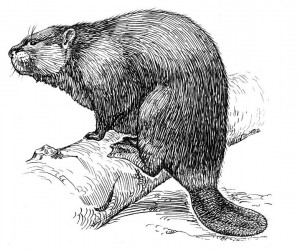This site is supported by you, the reader. If you make a purchase through one of my links, I may earn a small commission. Learn more here.
 “You want a front foot or a back foot catch?”
“You want a front foot or a back foot catch?”
That was the question from a professional beaver trapper here in nothern Maine when I asked for advice on foothold beaver trapping. To be honest, I really hadn’t thought about it much….I just wanted to catch the beaver!
Beaver trapping with footholds can be extremely effective in open water. At its most basic level, you’re catching a beaver in a foothold trap near the bank or shore as it approaches or leaves dry ground. This can be done in blind trail sets or baited sets, but the most popular method is probably the castor mound set.
In a castor mound set, you’re taking advantage of the beaver’s frequent visits to castor mounds along the shore of its home range. Like scent posts in predator trapping or rubs and scrapes used by whitetails, the castor mound is the beaver’s way of making its territory known to other beavers. You can use existing castor mounds, or construct artificial ones to attract beavers.
Foothold traps are typically placed under water as the beaver approaches shore and has to step foot on bottom to climb out of the water. Then, in most cases, the trap is attached to a one-way cable setup that sends the beaver to deeper water for a quick dispatch. It’s called a drowning set. Sounds a bit distressing to some, but in reality the animal holds its breath, CO2 builds up and it’s lights out in a matter of minutes. It’s one of the more quick and humane ways to dispatch furbearers.
Front Foot Catch
The front foot catch is designed for the beaver to step on the trap pan and be caught by the front foot. This is achieved by placing the trap in just a few inches of water right near shore. There are a couple of benefits to the front foot catch. For starters, it makes for an effective drowning set in relatively shallow water, simply because the front foot is closer to the animal’s head. Makes perfect sense. Some would also argue that it’s easier to direct the foot to the trap pan using guide sticks, etc. in shallow water.
There are a couple of drawbacks to the front foot catch, though. Often times when approaching the shore, Mr. Beaver is carrying sticks, either for a building project or a snack. It’s common for these sticks to set off the trap, or the beaver’s belly to set off the trap before he gets his foot down. Another drawback is that the front foot is much smaller and more fragile than the back foot, and there’s some chance of wringing out or pulling the foot out of the trap in a less than ideal catch. Finally, there’s a better chance of catching a nontarget in the shallower front foot set, usually a muskrat and sometimes a mink. This may be a good thing or a bad thing, depends on what you’re looking for.
Back Foot Catch
The back foot catch is used in the same situation as the front foot catch, except that the trap is set in deeper water further back from the shore – typically a forearm’s distance back and a forearm’s depth. Set this way, the beaver is caught by the hind foot as it’s planted on the ground to ascend up the bank. The advantage of the back foot catch is that the hind foot is much larger and more rugged, making it more likely to achieve a solid hold with the trap. The disadvantage, as you might guess, is that it takes deeper water to achieve a successful drowning set. It’s also more difficult to guide the beaver to step on the trap as it’s set so deep in the water.
The front foot vs. back foot debate among foothold beaver trappers is one of the more common ones in trapping discussions. Both can be successful, but each is unique and situation-dependent. So what do you want, a front foot or a back foot catch? If you’re like me, your front foot sets will catch hind feet, and vice versa. Sometimes it takes a lot of experience to fine tune the beaver foothold methods, and other times it won’t matter how good you are – the beaver will be caught the way it’s caught!
Leave a Reply